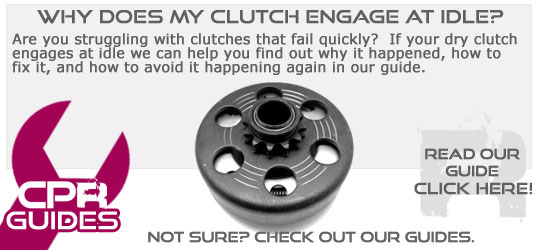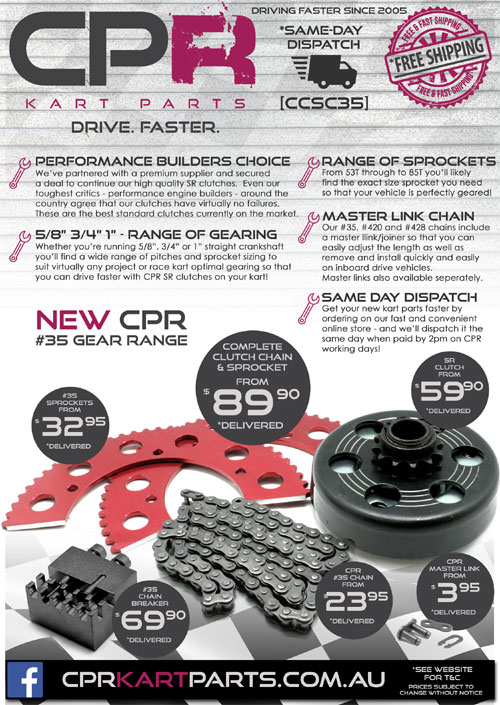GUIDE Why Does My Clutch Engage At Idle
GUIDE Why Does My Clutch Engage At Idle
GUIDE - WHY DOES MY CLUTCH ENGAGE AT IDLE?
One of the things we are constantly asked is why a particular customer's dry centrifugal clutch has failed. We've decided to write an informative guide to help understand how Dry Centrifugal Clutches work
Learn how to install a dry clutch by CLICKING HERE
Learn how to service and repair a CPR SR clutch by CLICKING HERE

CONTENTS
1. How does the Dry Centrifugal Clutch work?
2. What causes failure in dry clutch systems?
3. What is the mimimum speed I need to travel at to stop my clutch from failing?
1. HOW DOES THE CPR SR CLUTCH WORK?
Basic dry centrifugal clutches run a very simple method of power transfer. This makes them incredibly inexpensilve - one of their major pros. Both our popular entry level stock clutch (such as the CLC3512) and our GT clutch (such as the CGT3512) both emply this technology slightly differently, but the concepts are the same.
The clutch comprises of three main pieces:
- The outer drum (and drive sprocket)
- CLC3512.jpg (7.36 KiB) Viewed 3241 times
- The friction material & arrestor spring(s)
- InnerB.jpg (6.68 KiB) Viewed 3240 times
- The transmission plate & central shaft. (central shaft not shown. Picture below shows friction material and spring installed)
- Inner.jpg (15.72 KiB) Viewed 3240 times
In the picture above you can see the friction material installed onto the transmission plate. You can see the transmission plate splines in the centre of the plate. The central shaft (not shown) slots into these splines and slides onto the crankshaft of the engine. It rotates with the engine because it is keyed and the key slots into the keyway on the crankshaft.
The drum sits over this material and is large enough so that the material does not contact the drum when it is fitted. You can rotate the drum freely when the unit is assembled as the friction material does not contact the drum.
As the speed of the crankshaft rotation increases (RPM increases) there is more and more centrifugal force on the friction material.
The spring holds them together in a tight circle and they do not touch the drum.
As the force pushing the friction material away from the centre increases to a point that it is greater than the force applied by the spring, the friction material starts to move outwards and contacts with the drum.
2. WHAT CAUSES THE CLUTCH TO FAIL?
This begins to happen somewhere between 1500rpm and 1800rpm on the standard DRY CLUTCHES. At this point, the drum is still slipping on the friction material because the amount of force is not great enough to overcome the friction from the back wheels. The more weight, the more friction. When the drum slips, it creates heat. This is the cause of immediate idle on a Dry Centrifugal Clutch. Limiting the slip of the drum is critical to ensuring the clutch does not fail.
NOTE: DRY CLUTCHES SHOULD NOT BE IDLED!
ONE MORE IMPORTANT THING TO NOTE IS THAT AFTER THE FIRST USE, SOME HEAT WILL INEVITABLY BE TRANSFERRED TO THE SPRING AND IT WILL STRETCH SLIGHTLY. FROM THIS POINT ON, AT IDLE, THE CLUTCH WILL SLOWLY BEGIN TO ENGAGE AT IDLE SPEED - THE HIGHER THE IDLE SPEED, THE MORE THE ENGAGEMENT WHICH WILL ACCELERATE WEAR.
At 2000rpm the friction material has so much centrifugal force applied to it that the spring can no longer arrest the material and it completely contacts the drum. This is considered it's FULLY ENGAGED rpm. Power is now transmitted directly through the chain to the rear drive sprocket and no further heat is created.
3. WHAT IS THE MINIMUM SPEED I NEED TO TRAVEL TO STOP CLUTCH FAILURE?
EXAMPLE 1 - Racing Go Kart with standard senior slick rear tyres, a 60T rear axle sprocket and a 12T clutch.
EXAMPLE 2 - Racing Go Kart with standard senior slick rear tyres, a 60T rear axle sprocket and a 12T clutch AND TORQUE CONVERTER.
By utilising a torque converter, we can reduce the minimum speed to a crawl but without affecting the maximum speed. This makes the torque converter system far more practical for off-road karts and kids karts where slow speeds are going to be common while the driver is learning.
1. Rolling Diameter of the Tyres
The initial differential ratio is 2.7:1


.jpg)
.jpg)
















